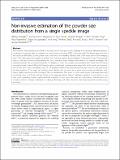| dc.contributor.author | Zhang, Qihang | |
| dc.contributor.author | Pandit, Ajinkya | |
| dc.contributor.author | Liu, Zhiguang | |
| dc.contributor.author | Guo, Zhen | |
| dc.contributor.author | Muddu, Shashank | |
| dc.contributor.author | Wei, Yi | |
| dc.contributor.author | Pereg, Deborah | |
| dc.contributor.author | Nazemifard, Neda | |
| dc.contributor.author | Papageorgiou, Charles | |
| dc.contributor.author | Yang, Yihui | |
| dc.contributor.author | Tang, Wenlong | |
| dc.contributor.author | Braatz, Richard D | |
| dc.contributor.author | Myerson, Allan S | |
| dc.contributor.author | Barbastathis, George | |
| dc.date.accessioned | 2024-11-27T20:22:02Z | |
| dc.date.available | 2024-11-27T20:22:02Z | |
| dc.date.issued | 2024 | |
| dc.identifier.uri | https://hdl.handle.net/1721.1/157694 | |
| dc.description.abstract | Non-invasive characterization of powders may take one of two approaches: imaging and counting individual particles; or relying on scattered light to estimate the particle size distribution (PSD) of the ensemble. The former approach runs into practical difficulties, as the system must conform to the working distance and other restrictions of the imaging optics. The latter approach requires an inverse map from the speckle autocorrelation to the particle sizes. The principle relies on the pupil function determining the basic sidelobe shape, whereas the particle size spread modulates the sidelobe intensity. We recently showed that it is feasible to invert the speckle autocorrelation and obtain the PSD using a neural network, trained efficiently through a physics-informed semi-generative approach. In this work, we eliminate one of the most time-consuming steps of our previous method by engineering the pupil function. By judiciously blocking portions of the pupil, we sacrifice some photons but in return we achieve much enhanced sidelobes and, hence, higher sensitivity to the change of the size distribution. The result is a 60 × reduction in total acquisition and processing time, or 0.25 seconds per frame in our implementation. Almost real-time operation in our system is not only more appealing toward rapid industrial adoption, it also paves the way for quantitative characterization of complex spatial or temporal dynamics in drying, blending, and other chemical and pharmaceutical manufacturing processes. | en_US |
| dc.language.iso | en | |
| dc.publisher | Springer Science and Business Media LLC | en_US |
| dc.relation.isversionof | 10.1038/s41377-024-01563-6 | en_US |
| dc.rights | Creative Commons Attribution | en_US |
| dc.rights.uri | https://creativecommons.org/licenses/by/4.0/ | en_US |
| dc.source | Springer Nature | en_US |
| dc.title | Non-invasive estimation of the powder size distribution from a single speckle image | en_US |
| dc.type | Article | en_US |
| dc.identifier.citation | Zhang, Q., Pandit, A., Liu, Z. et al. Non-invasive estimation of the powder size distribution from a single speckle image. Light Sci Appl 13, 200 (2024). | en_US |
| dc.contributor.department | Massachusetts Institute of Technology. Department of Electrical Engineering and Computer Science | en_US |
| dc.contributor.department | Singapore-MIT Alliance in Research and Technology (SMART) | en_US |
| dc.contributor.department | Massachusetts Institute of Technology. Department of Chemical Engineering | en_US |
| dc.contributor.department | Massachusetts Institute of Technology. Department of Mechanical Engineering | en_US |
| dc.relation.journal | Light: Science & Applications | en_US |
| dc.eprint.version | Final published version | en_US |
| dc.type.uri | http://purl.org/eprint/type/JournalArticle | en_US |
| eprint.status | http://purl.org/eprint/status/PeerReviewed | en_US |
| dc.date.updated | 2024-11-27T20:09:22Z | |
| dspace.orderedauthors | Zhang, Q; Pandit, A; Liu, Z; Guo, Z; Muddu, S; Wei, Y; Pereg, D; Nazemifard, N; Papageorgiou, C; Yang, Y; Tang, W; Braatz, RD; Myerson, AS; Barbastathis, G | en_US |
| dspace.date.submission | 2024-11-27T20:09:24Z | |
| mit.journal.volume | 13 | en_US |
| mit.journal.issue | 1 | en_US |
| mit.license | PUBLISHER_CC | |
| mit.metadata.status | Authority Work and Publication Information Needed | en_US |
